Embarking on the journey of astrophotography or simply gazing at the night sky often begins with a fundamental question: where exactly is the Milky Way? For beginners and seasoned stargazers alike, pinpointing our galaxy can seem daunting. Many aspiring astrophotographers, when starting out, face the initial hurdle of knowing where to aim their cameras to capture the breathtaking expanse of the Milky Way. Visibility is key, and understanding when and where to look is paramount. The Milky Way’s position in the night sky is dynamic, shifting throughout the night and changing with the seasons. This guide will provide you with the essential tools and knowledge to confidently locate the Milky Way, enhancing your stargazing and astrophotography endeavors.
Seasons of the Night Sky: Timing Your Milky Way Observation
It’s a common experience for newcomers to night sky observation and photography to venture out, eager to capture the iconic bright galactic center of the Milky Way, only to find it absent from view. This often leads to confusion and the realization that the night sky, much like our year, has seasons. The portion of the Milky Way visible to us changes depending on the time of year, a crucial factor to consider for successful observation.
 Milky Way over Trona Pinnacles landscape
Milky Way over Trona Pinnacles landscape
For those aiming to witness and photograph the brilliant galactic center of the Milky Way, the optimal period across the globe generally falls between mid-March and mid-October. This timeframe is often celebrated as the “Milky Way Season” within the astrophotography community. While segments of the Milky Way can technically be observed year-round, the months from September to April present a challenge. During this period, the bright galactic center is obscured by the Sun, limiting visibility to the dimmer regions of our galaxy.
 Milky Way arching over Reno cityscapeFrom approximately March to October, the galactic center becomes visible during specific hours of the night. This image highlights the constellations Sagittarius and Scorpius, regions rich with celestial wonders.
Milky Way arching over Reno cityscapeFrom approximately March to October, the galactic center becomes visible during specific hours of the night. This image highlights the constellations Sagittarius and Scorpius, regions rich with celestial wonders.
Geographic location also plays a significant role in Milky Way visibility. In the Northern Hemisphere, the galactic center graces the southern portion of the sky. Conversely, in the Southern Hemisphere, particularly during the peak Milky Way season around the June Solstice, it can be found directly overhead. Many astrophotographers in the Northern Hemisphere, like myself, find that the galactic center remains relatively low on the horizon.
 Dimmer part of Milky Way near Cassiopeia constellationBetween September and April, the dimmer sections of the Milky Way are observable, offering a different perspective of our galaxy. This view showcases the region near the constellation Cassiopeia.
Dimmer part of Milky Way near Cassiopeia constellationBetween September and April, the dimmer sections of the Milky Way are observable, offering a different perspective of our galaxy. This view showcases the region near the constellation Cassiopeia.
Astrophotography, as a dedicated pursuit, often shifts the focus from equipment to astronomical awareness. Understanding our place in the cosmos—Earth’s, Moon’s, and Sun’s positions in their celestial dance—becomes paramount. With practice and keen observation, tracking celestial movements becomes intuitive, aiding in planning astrophotography expeditions.
To aid you in your quest, I’m excited to share my preferred tools and techniques for locating the Milky Way’s galactic plane and, more precisely, the radiant galactic center. Below, you’ll find my top recommendations for smartphone applications and desktop software designed to guide you in finding the Milky Way, alongside methods for locating it without relying on technology. These resources will not only help you find the Milky Way in the sky but also explore the “Milky Way Online,” in terms of planning and learning.
Top Smartphone Apps for Milky Way Discovery
In the digital age, smartphone applications have revolutionized how we interact with the night sky. For those seeking to find the Milky Way online and offline, these apps are invaluable. After extensive testing, I’ve curated a list of the most exceptional apps for Milky Way enthusiasts. While numerous free apps attempt similar functionalities, these selected applications stand out for their superior performance and features.
PhotoPills for iOS and Android
 PhotoPills app screenshots on mobile devices
PhotoPills app screenshots on mobile devices
PhotoPills emerges as a leading application for comprehensive photography planning, compatible with both Apple iOS and Android devices. Its augmented reality (AR) mode and 2D Milky Way planner are particularly groundbreaking for night photography, setting PhotoPills apart.
The 2D Milky Way Planner is exceptionally useful for visualizing the galactic plane’s arc overlaid on a map. This feature simplifies planning your shooting location to perfectly align the Milky Way with your chosen landscape.
The Night AR function elevates pre-visualization even further. By simply pointing your smartphone camera, you can witness the Milky Way’s position at any given time, even hours before nightfall. This AR tool offers near-perfect accuracy in predicting the galactic center’s location, enabling precise composition planning.
The unique combination of these tools positions PhotoPills as arguably the premier Milky Way planning application. To further enhance your Milky Way photography skills, PhotoPills offers an in-depth guide that complements the resources available here on Lonely Speck, providing a comprehensive “milky way online” learning experience.
SkyGuide for iOS
 SkyGuide app screenshots on iPad and iPhone
SkyGuide app screenshots on iPad and iPhone
While PhotoPills excels in planning Milky Way photography, SkyGuide offers a deeper dive into night sky exploration. It’s ideal for identifying constellations, nebulae, planets, and satellites, enriching your understanding of celestial objects.
SkyGuide stands out with its photorealistic depiction of the night sky. Created by Nick Risinger, the mind behind skysurvey.org, SkyGuide incorporates a detailed mosaic of the night sky compiled from over 30,000 exposures captured from various global locations. This rich detail makes SkyGuide my preferred choice for visually exploring the night sky on iOS, allowing users to orient their devices and locate the galactic plane with ease.
Stellarium Mobile
 Stellarium Mobile app screenshots on Android and iOS
Stellarium Mobile app screenshots on Android and iOS
For Android users, Stellarium Mobile serves as an excellent alternative to SkyGuide, which is exclusive to iOS. Stellarium Mobile is the commercial mobile version of the popular desktop planetarium software, stellarium.org. It also utilizes the skysurvey.org mosaic for Milky Way representation, though at a lower resolution than SkyGuide. A helpful tip for Stellarium Mobile users is to increase the Milky Way brightness in the “Advanced” settings for enhanced visibility. Similar to PhotoPills and SkyGuide, Stellarium Mobile leverages your device’s compass and accelerometers to dynamically display the Milky Way’s position as you move your phone. Stellarium Mobile is also available for iOS, though my preference remains with SkyGuide for Apple devices. Both apps provide a portal to the “milky way online” of information and visual representation.
Best Desktop Application for Milky Way Exploration
Stellarium.org
 Stellarium desktop software screenshot
Stellarium desktop software screenshot
Concluding my list of essential Milky Way finding tools is Stellarium.org. This free, open-source desktop application is available across Mac, Linux, and Windows platforms, with a browser version for Chromebook users. Stellarium desktop is the foundation for Stellarium Mobile and stands as my preferred software for in-depth planning on a computer. Its comprehensive features and user-friendly interface make it an invaluable resource for anyone serious about exploring the “milky way online” and in the real sky.
Locating the Milky Way Without Technological Aids
It might seem paradoxical to discuss “finding” the Milky Way when we are, in fact, within it. Every visible star in the night sky is part of our Milky Way galaxy. Therefore, when we talk about finding the Milky Way, we’re specifically referring to identifying the Milky Way galactic plane, or even more precisely, the luminous galactic center. Let’s begin with an image of the Milky Way captured at Trona Pinnacles, California, for visual reference:
 Milky Way galactic center above Trona Pinnacles
Milky Way galactic center above Trona Pinnacles
The intensely bright region of the Milky Way, positioned just above the prominent pinnacle, is the galactic center—the radiant core around which our solar system revolves. Our Sun completes an orbit around this galactic center approximately every 240 million years. In this photograph, the galactic plane extends vertically from the frame. On any clear, dark night, a segment of the galactic plane is typically visible from most locations worldwide. The galactic plane manifests as an arc across the sky, generally characterized by a higher concentration of stars. This star-rich band is the focal point for astrophotographers and stargazers alike.
In sufficiently dark locations, the Milky Way is often discernible to the naked eye, though its visual impact is less pronounced than in long-exposure photographs. Memorizing key constellations along the galactic plane is incredibly beneficial for orientation. While numerous constellations reside within the galactic plane, focusing on these six will significantly aid in your Milky Way searches, especially in light-polluted areas where the Milky Way’s position may be less obvious. At least one of these constellations is likely to be visible on any given night, and they are among the easiest to learn and recognize.
Key Constellations Along the Milky Way Galactic Plane:
- Scorpius
- Sagittarius
- The Summer Triangle
- Cassiopeia
- Crux (Southern Cross)
- Orion
Scorpius
Scorpius, a personal favorite constellation, is distinguished by Antares, a brilliant star known as “The Heart of the Scorpion.” It is accompanied by a curved line of stars outlining the scorpion’s body. Antares is notable for its intense orange-yellow hue, setting it apart from surrounding stars, and is one of the brightest stars in the sky. The Rho Ophiuchi cloud complex, a vibrant area of colorful stars and dark dust clouds, surrounds Antares, enhancing the constellation’s visual appeal.
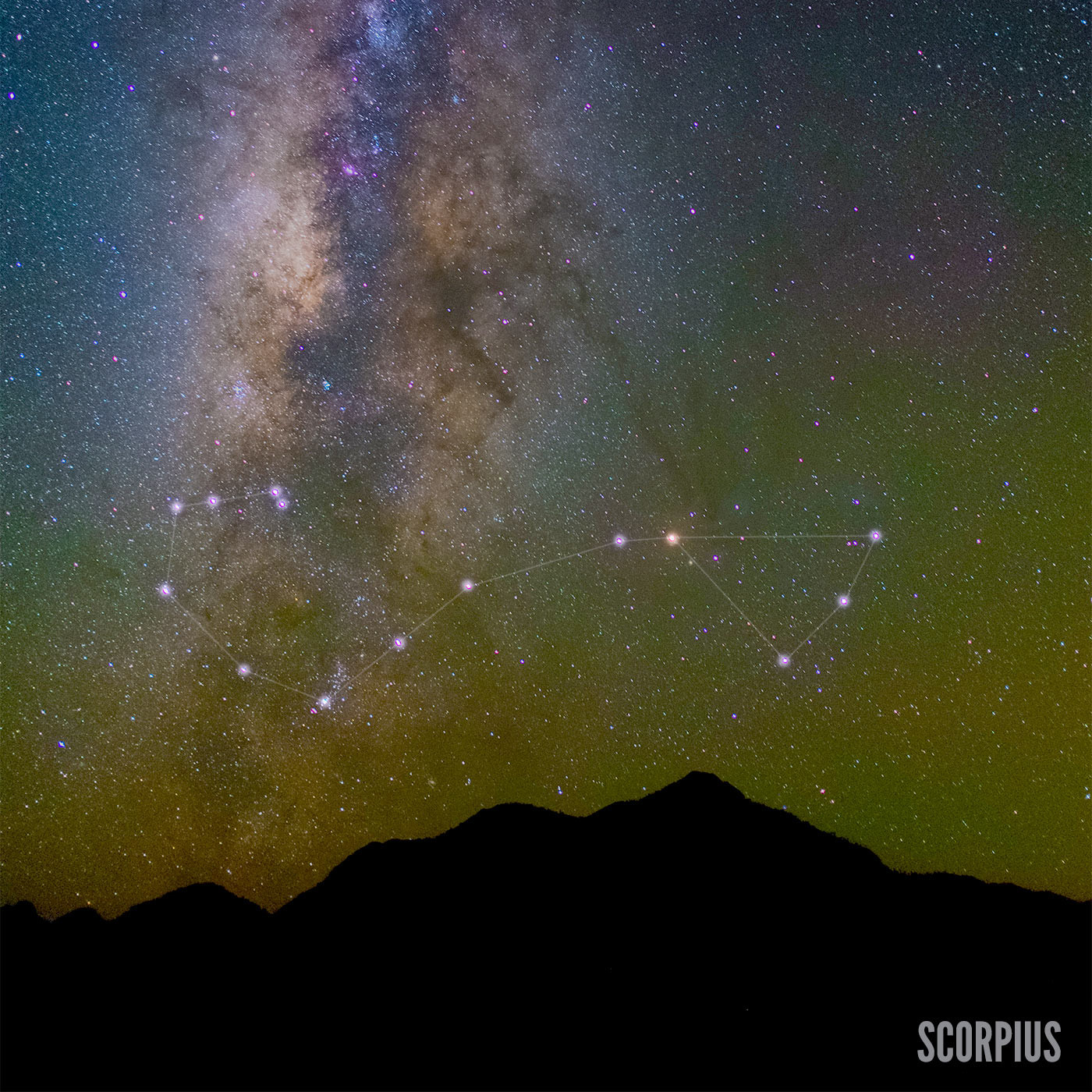 Scorpius constellation with Antares star
Scorpius constellation with Antares star
Sagittarius
Sagittarius is situated almost precisely at the most luminous part of the Milky Way. Given the dense concentration of stars in this area, Sagittarius can be challenging to discern initially. However, it serves as a direct indicator of the night sky’s brightest region. While traditionally depicted as a centaur archer, the most prominent stars of Sagittarius form a more readily identifiable “teapot” shape. The teapot’s spout points directly towards the galactic center’s bright bulge.
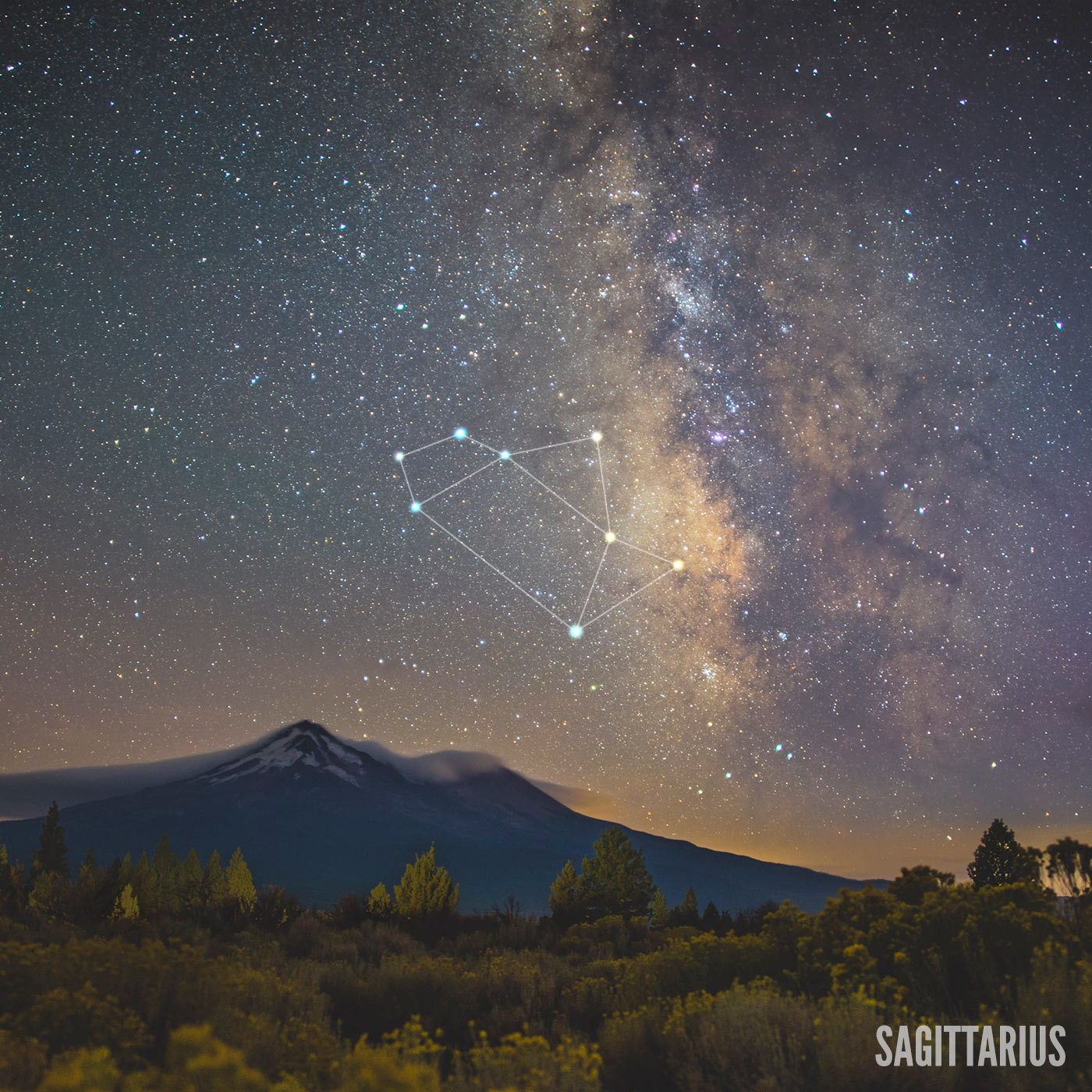 Sagittarius constellation resembling a teapot shape
Sagittarius constellation resembling a teapot shape
The Summer Triangle
In the Northern Hemisphere, the Summer Triangle is particularly useful for locating the galactic plane. This region of the Milky Way is home to three remarkably bright stars: Deneb (in Cygnus, the swan), Altair, and Vega. These stars are among the brightest visible during the Northern Hemisphere’s summer, typically high in the sky from May to July. Deneb is especially noteworthy for photographers as it is situated near the vibrant pink North American Nebula.
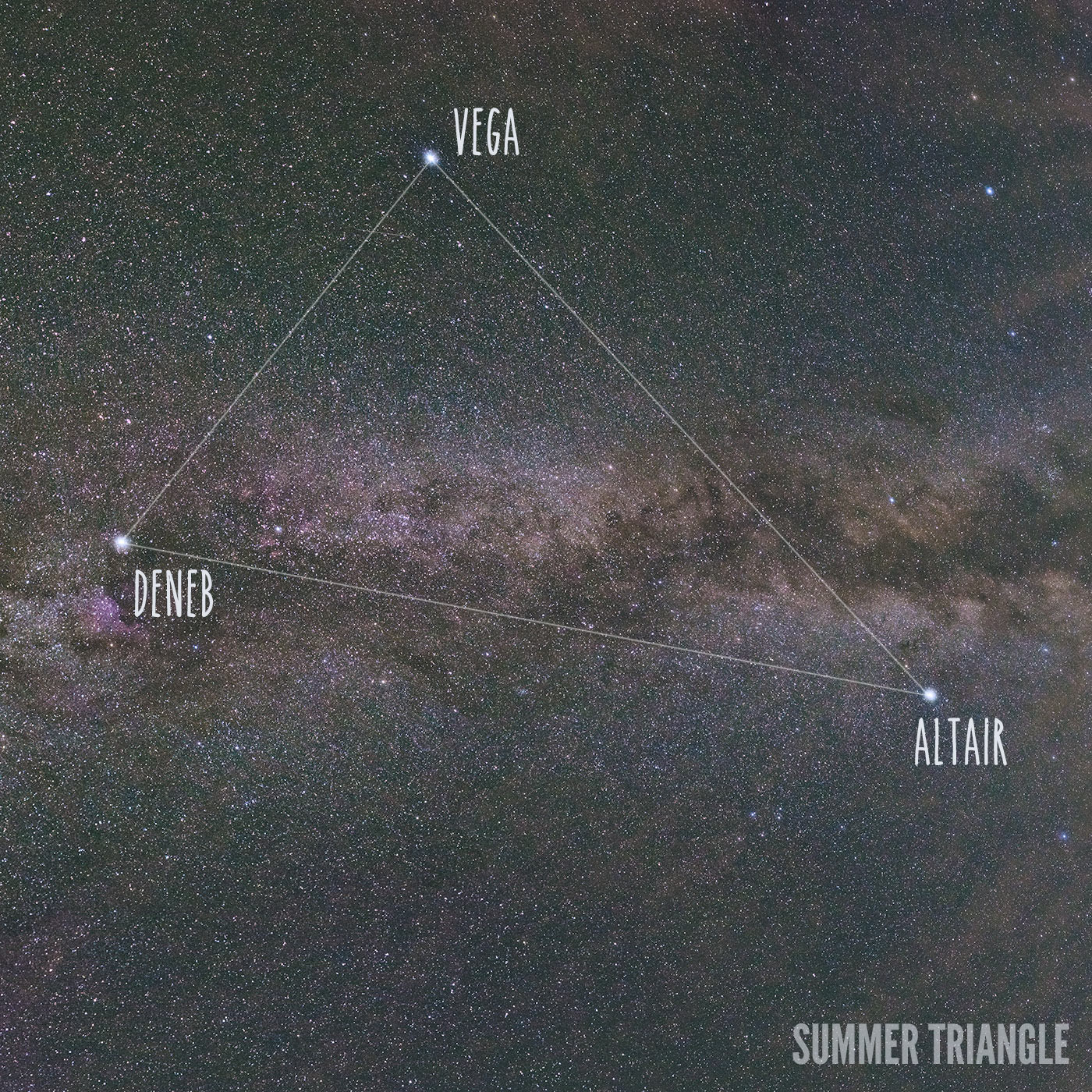 Summer Triangle asterism with bright stars Deneb, Altair, and Vega
Summer Triangle asterism with bright stars Deneb, Altair, and Vega
Cassiopeia
Visible almost year-round in the Northern Hemisphere, Cassiopeia is easily recognizable by its distinctive “W” shape in the night sky. As one of the northernmost constellations, it is located near Polaris, the North Star. I also utilize Cassiopeia as a guide to find the Andromeda Galaxy, our nearest large galactic neighbor, which appears to the right of Cassiopeia in the image below.
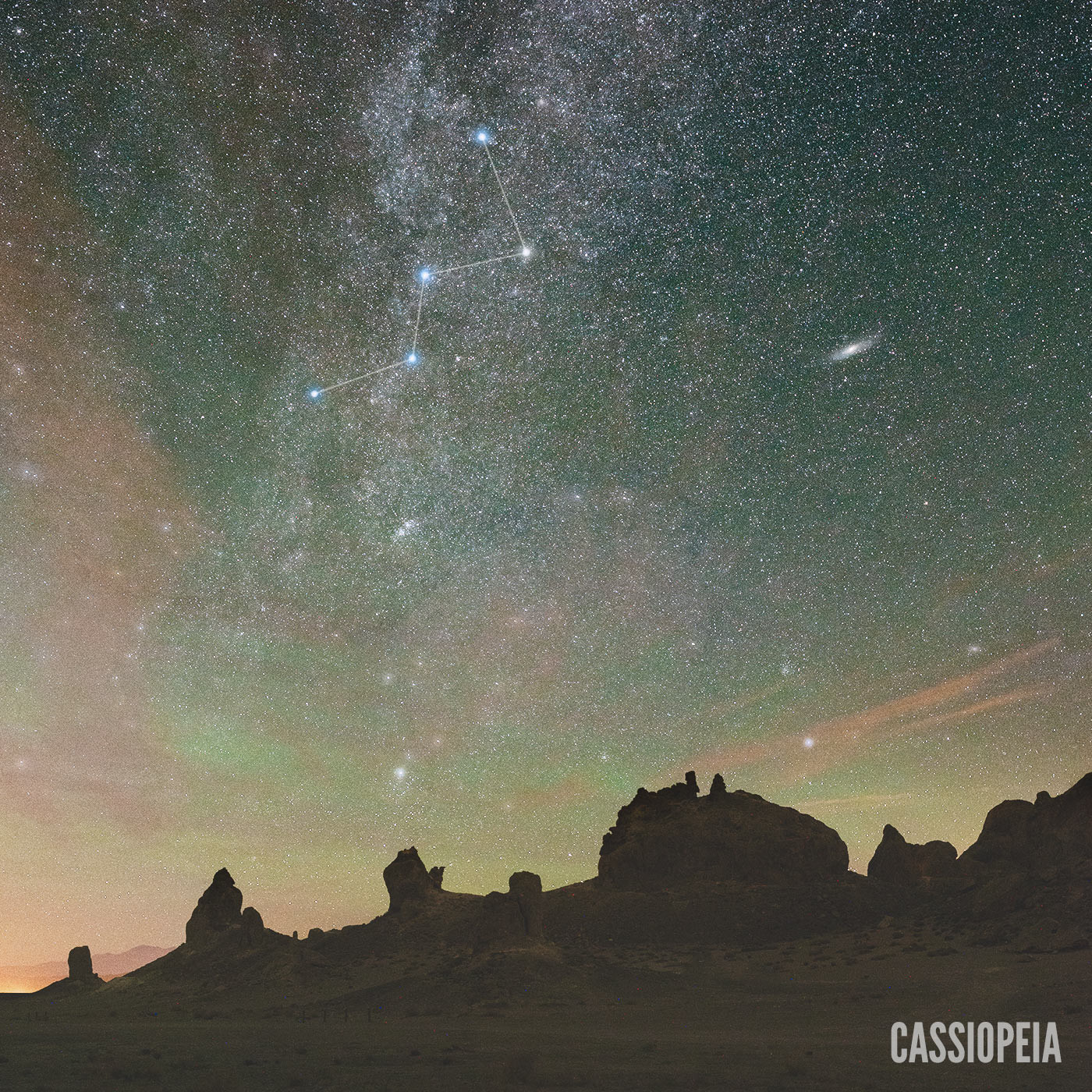 Cassiopeia constellation in a W shape near Andromeda galaxy
Cassiopeia constellation in a W shape near Andromeda galaxy
Crux or the Southern Cross
In the Southern Hemisphere, Crux, or the Southern Cross, is a prominent constellation resembling a nearly perfect cross, composed of some of the brightest stars in the southern sky. It is positioned directly on the galactic plane, making it a key marker for Milky Way observers in the south.
 Crux constellation or Southern Cross in the night sky
Crux constellation or Southern Cross in the night sky
Orion
Orion becomes most prominent during the “quiet season” of the night sky, from September to April. Situated near the galactic plane, almost opposite to the galactic center, Orion is instantly recognizable by the three bright stars forming Orion’s Belt. I particularly enjoy photographing Orion due to its abundance of colorful nebulae and bright stars. Orion is a favored region of the night sky, and I’ve created a dedicated tutorial on photographing Orion for those interested in capturing its beauty.
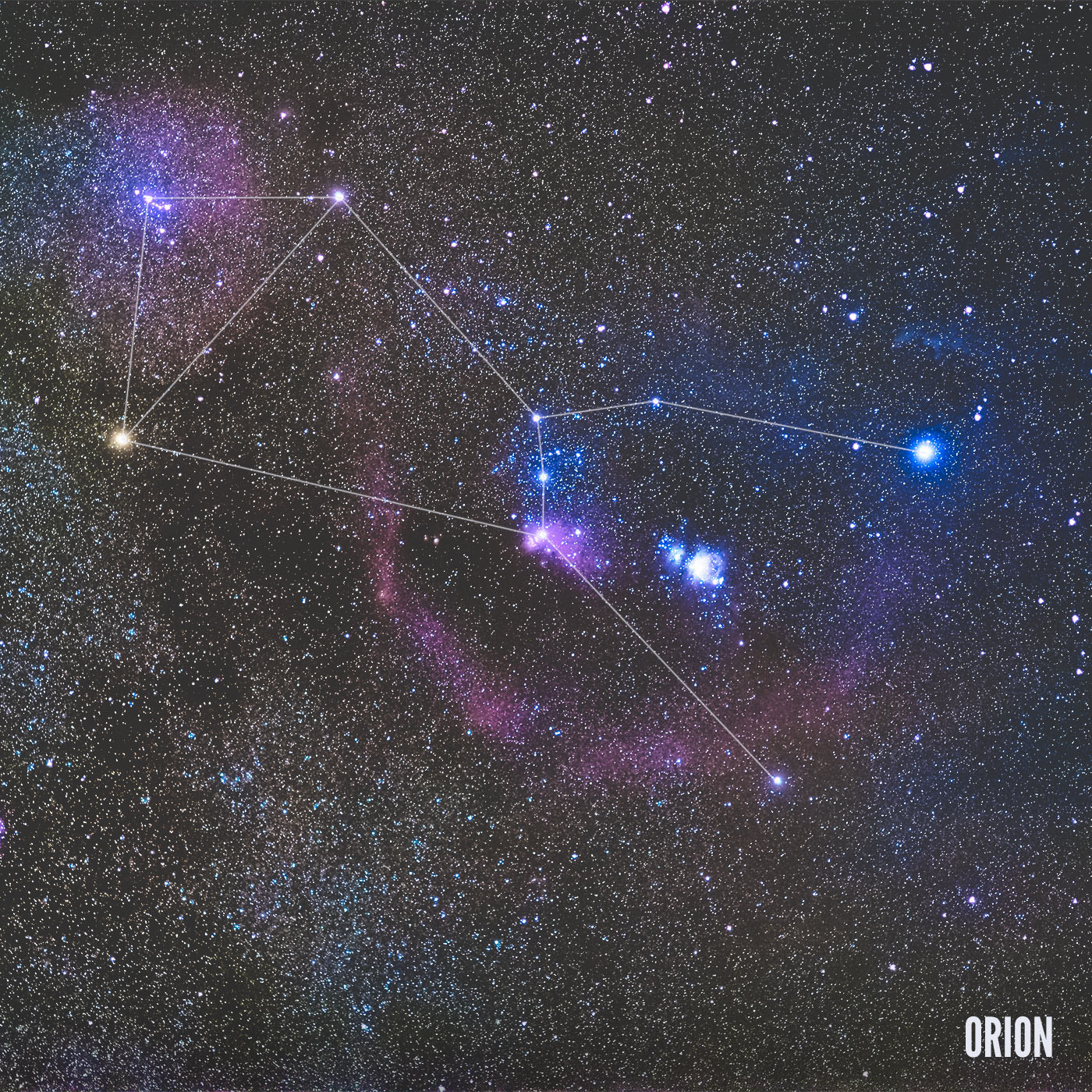 Orion constellation with belt stars and nebulae
Orion constellation with belt stars and nebulae
These constellations serve as your navigational tools for finding the Milky Way. Utilize smartphone apps to aid in locating and learning these constellations. With a few stargazing sessions, you’ll become proficient in recognizing these vital parts of our home galaxy. Equipped with clear, dark skies and basic photographic gear—a camera, fast lens, and tripod—you’ll be well-prepared to photograph the Milky Way. For further guidance, explore online resources and communities dedicated to astrophotography and “milky way online” learning. If you have any questions or insights, please share them in the comments below.
I trust this guide has been helpful. To deepen your knowledge of Milky Way photography, explore the rest of our Astrophotography 101 lessons or directly proceed to How to Photograph the Milky Way.
Disclosure
We participate in affiliate advertising programs, including the Amazon Services LLC Associates Program and the B&H Affiliate Program. These programs allow us to earn fees by linking to Amazon.com and bhphotovideo.com, supporting our ability to provide valuable content.
Learn Astrophotography
Astrophotography 101 is accessible to everyone for free. All lessons are available on the Lonely Speck Astrophotography 101 page. Subscribe with your email to receive updates on new lessons, typically less than once per week, ensuring your email remains secure and spam-free.
Support Our Work
Lonely Speck is sustained by community support. We appreciate the vibrant community that has grown around learning astrophotography and are grateful to be a part of it. If you find our articles beneficial, please consider making a donation to help us continue providing resources. For questions or to share your photography journey, contact us.
Thank you for joining our astrophotography adventure.
-Ian
Back to Astrophotography 101
